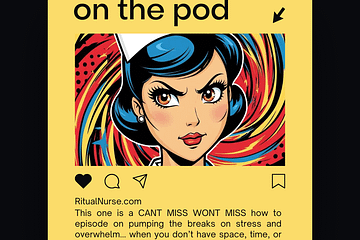Innovative Strategies for Nurse Recovery and Distress Tolerance in High-Stress Environments
Table of contents
• Introduction
• Understanding Nurse Burnout and Distress
• Innovative Strategies for Nurse Recovery
• Distress Tolerance Techniques for Nurses
• Creating Supportive Work Environments
• Utilizing Technology for Nurse Well-being
• Conclusion
Introduction
Introduction:
Being a nurse is indeed a rewarding profession. But let’s not forget the demanding part, shall we? Long shifts, emotional toll, and chronic stress are just a few things that can lead to burnout. But fear not, my fellow caregivers! There are innovative strategies out there to help you recover and tolerate the distress that comes with working in high-stress environments. So, let’s dive right in and explore these strategies, shall we? Trust me, it’ll be worth it!
Understanding Nurse Burnout and Distress
Working in the nursing field can be a rollercoaster ride of emotions. It’s a profession filled with the highs of making a difference in people’s lives and the lows of dealing with stress and burnout. So, what exactly is nurse burnout? Well, it’s like trying to juggle 10 patients at once while a fire is burning in the background. It’s the feeling of exhaustion, cynicism, and a lack of accomplishment that can creep up on even the most dedicated and passionate nurses.
Causes of nurse burnout can be as diverse as the patients they care for. Long hours, heavy workloads, and the pressure to excel can all contribute to the burnout train. It’s like pushing a boulder uphill, only for it to roll back down just as you think you’ve made progress. And if left unchecked, this burnout can have some serious effects on both the nurses and the patients they care for.
Emotional exhaustion, cynicism, and a reduced sense of personal accomplishment are just a few of the effects of nurse burnout. It’s like feeling emotionally drained, detached from your work, and questioning your ability to make a difference. It’s the feeling of being stuck in a hamster wheel, spinning round and round without any sense of achievement.
But fear not, my fellow nurses! There are innovative strategies for nurse recovery that can help prevent and manage burnout. It’s like a ray of sunshine breaking through the clouds after a long and gloomy day. Self-care practices, promoting work-life balance, and providing mental health support are all ways we can lift ourselves up and combat burnout.
So, let’s grab our stethoscopes and dive deeper into these strategies to discover how we can take care of ourselves and keep our passion for nursing alive. After all, we can’t pour from an empty cup, and our patients deserve the best care possible. Let’s tackle burnout head-on and create a stronger, happier, and more resilient nursing community.
Innovative Strategies for Nurse Recovery
Working as a nurse can be incredibly demanding, both physically and emotionally. The long hours, high-stress environments, and constant pressure to provide the best care possible can take a toll on even the most dedicated nurses. That’s why it’s essential to implement innovative strategies for nurse recovery and distress tolerance.
Self-care practices for nurses are crucial in preventing burnout and maintaining overall well-being. Nurses need to prioritize their own health and happiness to be able to effectively care for others. Whether it’s taking regular breaks, engaging in hobbies outside of work, or practicing self-reflection, finding ways to recharge and rejuvenate is essential.
Promoting work-life balance is another key strategy for nurse recovery. It’s all too easy for nurses to let their work consume their lives, but finding a healthy balance between work and personal life is vital for preventing burnout. Encouraging nurses to set boundaries, take time off when needed, and prioritize their own needs can go a long way in fostering a sense of well-being.
Providing mental health support is crucial for nurses who may be experiencing distress or burnout. As healthcare professionals, nurses are often exposed to traumatic events and high levels of stress. Creating a supportive work environment that offers access to counseling services, peer support programs, and mental health resources can make a significant difference in the well-being of nurses.
By implementing these innovative strategies for nurse recovery, healthcare organizations can help prevent burnout and support the well-being of their nursing staff. Remember, a happy and healthy nurse is better equipped to provide exceptional care to patients. So let’s prioritize the well-being of nurses and show them the support they truly deserve. Trust me, it’s a win-win situation!
Distress Tolerance Techniques for Nurses:
Being a nurse is no easy feat. I mean, who would have thought that dealing with sick patients, working long hours, and managing high-stress situations could lead to burnout? Oh wait, everyone could have predicted that! But fear not, my fellow nurses, because I’m here to share some innovative strategies that can help you recover and build distress tolerance in those high-pressure environments.
First up, we have mindfulness and meditation. Yes, I know what you’re thinking. “Mindfulness? Meditation? Are you suggesting we sit cross-legged on the hospital floor and chant ‘om’?” Well, not exactly. But incorporating mindfulness practices into your daily routine can work wonders. Take a few moments to focus on your breath, clear your mind, and let go of the chaos around you. Trust me, it’s like a mini-vacation for your brain.
Next, let’s talk about stress management exercises. No, I’m not suggesting you hit the gym and lift weights while wearing your scrubs (although that would be quite the sight!). I’m talking about finding activities that help you unwind and release stress. Whether it’s going for a run, practicing yoga, or painting, find something that helps you decompress and refuel your mental and emotional well-being. Remember, self-care is not a luxury—it’s a necessity.
Lastly, building resilience is key. Let’s face it, nursing is tough, and there are bound to be moments when you feel like throwing in the towel. But building resilience can help you bounce back from those challenging moments. Surround yourself with a support system of colleagues, friends, and family who understand the demands of your job. Lean on them when you need to vent, seek advice, or simply have a good laugh. Humor goes a long way, my friends.
So there you have it, some distress tolerance techniques for all you hardworking nurses out there. Remember, taking care of yourself is just as important as taking care of your patients. So go ahead, give mindfulness a chance, find a stress-busting activity, and build that resilience like a superhero. You’ve got this! And always remember, laughter is the best medicine (well, maybe not always, but it definitely helps!).
Now, let’s move on to creating supportive work environments and utilizing technology for nurse well-being. Stay tuned!
Creating Supportive Work Environments
Effective communication and teamwork: In a high-stress environment like nursing, effective communication and teamwork are invaluable. It’s essential for nurses to be able to openly and honestly communicate with their colleagues, including sharing their concerns, challenges, and frustrations. By creating an environment where teamwork is encouraged and valued, nurses can feel supported and understood. This not only improves the overall work atmosphere but also enhances the quality of patient care. Because let’s face it, no one wants to work in a place where they’re constantly being undermined or left to fend for themselves.
Recognition and rewards: Nurses work incredibly hard, often going above and beyond to provide the best possible care for their patients. So, it’s only fair that they receive recognition and rewards for their efforts. This can be as simple as a pat on the back or a shout-out during staff meetings. It’s not rocket science – a little appreciation goes a long way in boosting morale and preventing burnout. After all, who doesn’t want to feel appreciated for their hard work? I know I would!
Reducing workload: Nursing can be an extremely demanding profession, with long hours and heavy workloads. So, finding ways to reduce the burden on nurses is crucial. This can be done by implementing strategies such as proper staffing ratios, efficient scheduling, and adequate breaks. By ensuring that nurses have manageable workloads, they’ll have more time to recharge and rejuvenate. Because let’s be real, no one wants to feel like they’re constantly drowning in work with no end in sight. We all need a break sometimes, even superheroes like nurses!
By prioritizing effective communication and teamwork, recognizing and rewarding nurses for their efforts, and reducing their workloads, healthcare organizations can create supportive environments that promote nurse well-being and prevent burnout. Because let’s face it, a happy and supported nurse is a better nurse. So, let’s invest in creating a workplace where nurses feel valued, appreciated, and empowered. After all, they’re the backbone of the healthcare system, and we all rely on them to keep us healthy and cared for.
Utilizing Technology for Nurse Well-being:
In this age of smartphones and digital advancements, technology has become an indispensable part of our lives. And nurses can also benefit from the wonders of technology when it comes to their well-being. So, let’s explore some innovative ways technology can support and enhance nurse well-being.
Virtual support systems: Picture this – a virtual space where nurses can connect with their peers, share their experiences, and find solace in knowing that they are not alone in their struggles.
Virtual support systems provide a platform for nurses to seek advice, vent their frustrations, and receive emotional support from fellow healthcare professionals who understand the challenges they face. It’s like having a virtual support group that fits right in your pocket!
Healthcare apps and tools: From wellness trackers to meditation apps, there is a plethora of healthcare apps and tools available that can assist nurses in their self-care journey. These apps can help nurses track their physical activity, monitor their sleep patterns, and even guide them through mindfulness and relaxation exercises. By integrating these apps into their daily routines, nurses can take proactive steps towards maintaining their mental and physical well-being.
Digital self-care resources: In today’s fast-paced world, finding time for self-care can be a challenge. But fear not, for technology has come to the rescue once again! Digital self-care resources offer nurses easy access to a wide range of self-care activities that can be done at their own convenience. Whether it’s virtual yoga classes, guided meditation sessions, or stress-reducing podcasts, these resources ensure that nurses can prioritize their well-being without adding extra pressure to their already hectic schedules.
By embracing these virtual support systems, healthcare apps, and digital self-care resources, nurses can empower themselves to take charge of their well-being. After all, taking care of others begins with taking care of oneself. So, let’s make the most of the technology available and ensure that nurses have the tools they need to thrive in high-stress environments.
Now that we’ve explored the innovative strategies for nurse recovery and distress tolerance, it’s time to put them into action. Remember, burnout won’t magically disappear overnight, but with determination, self-care practices, and a supportive work environment, nurses can take steps towards preventing burnout and finding balance in their lives. So, let’s prioritize nurse well-being, because a healthy and happy nurse equals exceptional patient care. Let’s break the cycle of burnout and create a culture where self-care is not just an afterthought, but an essential part of the nursing profession. It’s time to thrive, not just survive!
_______________________________
Phew! We’ve come to the end of this informative rollercoaster ride on nurse burnout and distress in high-stress environments. Let’s quickly recap the key points we’ve covered:
Firstly, we delved into the understanding of nurse burnout and distress. We learned that nurse burnout is not just about feeling tired or overwhelmed but involves physical and emotional exhaustion, detachment, and a sense of ineffectiveness. It can be caused by various factors such as long hours, heavy workloads, and lack of work-life balance. The consequences of nurse burnout can be detrimental to both the mental health of nurses and the quality of patient care.
But fear not, because we then moved on to discuss some innovative strategies for nurse recovery. Self-care practices for nurses, promoting work-life balance, and providing mental health support were some of the effective ways we explored to help nurses cope with burnout. As we ventured further, we discovered distress tolerance techniques like mindfulness, stress management exercises, and building resilience – all aimed at bolstering nurses’ ability to handle high-stress situations.
Creating supportive work environments also emerged as a crucial aspect in combating nurse burnout. Effective communication and teamwork, recognition and rewards, and reducing workloads were highlighted as important tools in fostering well-being among nurses. Lastly, we explored the role of technology in nurse well-being, with a focus on virtual support systems, healthcare apps, and digital self-care resources.
In conclusion, nurse burnout and distress are serious issues that need to be addressed in high-stress environments. By implementing innovative strategies for nurse recovery and distress tolerance, creating supportive work environments, and utilizing technology, we can empower nurses to take care of their mental and emotional well-being. It’s time to prioritize the well-being of those who dedicate their lives to caring for others. They deserve it!


